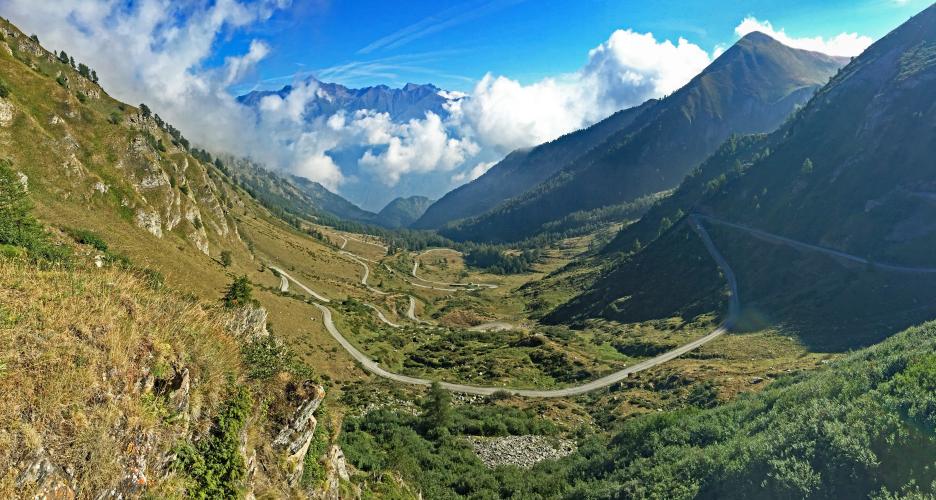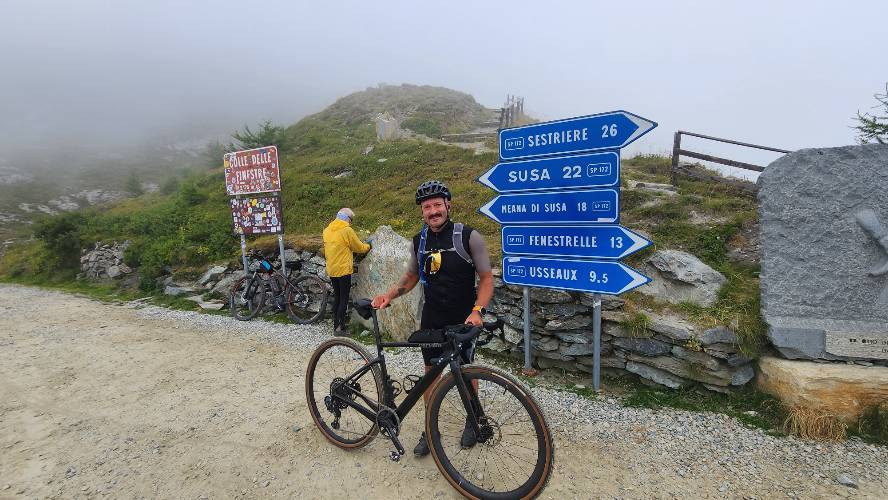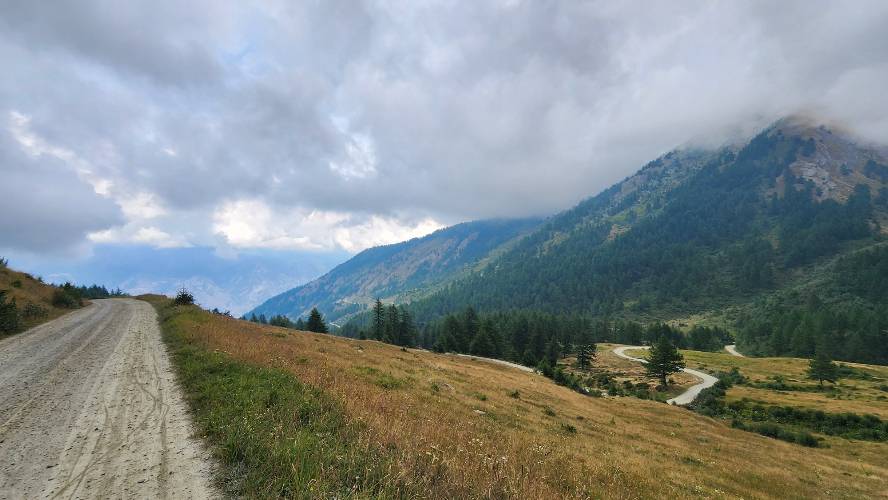![]()
Cycling Colle de Finestre
Ride 16.9 kilometers gaining 1672 meters at 9.9% average grade.
![Colle delle Finestre Cycling Colle delle Finestre - photo of the colle, roadway, fort]()
Colle is dead center of the photo.
This is one of the most difficult climbs in Italy and, while a bit of an outlier, is well worth the day or overnight trip to Susa to experience it -- you won’t be disappointed. At 10.5 miles / 16.9 kilometers, the distance is not exceptional, yet we gain 5,500’ / 1,680m at 10.2% average grade over that moderate distance.
![Colle delle Finestre - Susa Bike climb Colle delle Finestre - start, tunnel, Giro d'Italia signs, road]()
Climb begins in Susa (pop. 6,686, 2011).
![]()
If you’re looking closely, you can see small religious figurines on a rock wall on the way up the climb.
One of the most unique features of Finestre is that it is the only lengthy climb on the Giro that includes an extended dirt/gravel section. We enter and stay on gravel at mile 5.8 / kilometer 9.3, at an average grade of 9.5%, gaining 2,000’ / 600m over that distance. While we road cyclists are generally averse to road bikes on gravel/dirt, this climb is manageable and can be easily accomplished on a road bike, although we recommend at least 25mm tires and well cushioned gloves for the descent.
![Colle delle Finestre - Start of gravel section Climbing Colle delle Finestre by bike - start of gravel - roadway, sign, arch]()
Beginning of the Finestre gravel -- mile 6.5 / kilometer 10.5.
GIRO HISTORY
How to Cycle Colle delle Finestre:
Begin in Susa and ride a short distance to the beginning of the climb at the “Y” of SP 172 and SP 24. Veer right and begin the paved portion of the climb by riding up SP 172. As of 2016 the climb was manageable with 28mm road tires, but 30+mm cross tires should be considered for a more comfortable ride. There is no support along this 17 kilometer, 10% average grade climb, so bring sufficient water and food.
![Colle delle Finestre - Colle sign Climbing Colle delle Finestre by bike - start of gravel - roadway, sign, arch]()
The website Sicycle by Simon Crisp attributes much to the Giro for Colle delle Finestre’s rise in popularity:
“Grand Tours are often remembered for one stage, and in 2005 it was the stage up the Col de Finestre. Sure, the stage actually finished at Sestriere, but after Discovery Channel’s Paolo Savoldelli had seemingly set up overall victory, the gravel roads of the Finestre saw him isolated by Di Luca, Simoni and Rujano, who looked like pulling off a coup on the timeless looking slopes of the wonderful climb. Italian TV even started broadcasting in black and white, such was the nostalgic and epic nature of the events that were unfolding before their eyes. It wouldn’t be used for a few more years yet, but the modern Giro’s motto of being the “world’s hardest race in the most beautiful place” was seemingly born here, as well as cementing the Giro’s reputation for originality and drama.”
![Colle delle Finestre - Susa hotel]()
We stayed in Susa a couple kilometers from the start of the climb.
This climb has been the Cima Coppi of the Giro twice (most recently in 2018) since that designation was first introduced in 1965 to honor arguably the Giro’s greatest participant of all time:
“The Cima Coppi is the title given to the highest peak in the yearly running of the Giro d'Italia, one of cycling's Grand Tour races. The mountain that is given this title each year awards more mountains classification points to the first rider than any of the other categorized mountains in the race.
The categorization was first introduced for the 1965 Giro d'Italia in honor of the late Fausto Coppi who won five editions of the Giro d'Italia and three mountain classification titles during his career. It was first announced on 22 April 1965 by then race director Vicenzo Torriani that the highest peak would award two times as many mountains classification points. Torriani thought of possibly awarding time bonuses to the first to summit the mountain; however, after many dissenting opinions, he opted to go award more mountains classification points.
The Cima Coppi changes from year to year, depending on the altitude profile of the Giro d'Italia, but the Cima Coppi par excellence is the Stelvio Pass, which at 2758 m is the highest point ever reached by the Giro. The Stelvio has been used in the 1972, 1975, 1980, 1994, 2005, 2012, 2014 and 2017 editions. It was also scheduled in 1965, 1988, and 2013, but in each case the course was modified due to weather conditions, with various effects on the Cima Coppi designation” (Wikipedia - Cima Coppi).
We enter Parco Naturale Orsiera-Rocciavré at just after mile 6 / kilometer 10, just before the gravel portion of the climb begins. There are a spectacular set of switchbacks beginning around mile three, followed by approximately 30 switchbacks before the gravel begins at mile 5.8 (9.3 km), and 11 more thereafter, giving Finestre a total of approximately 40 switchbacks, thus rivalling the greatest Italian and European climbs for most switchbacks (more than Stelvio from the Bormio side, and just under Stelvio from the famous Prato direction). The Marco Pantani Memorial is located at about mile 5.8 / kilometer 10 (just shy of the start of the gravel). Unfortunately, the Memorial was not open when we passed on either the ascent or descent.
![Colle delle Finestre - Pantani memorial Climb by bike Colle delle Finestre - Pantani memorial]()
Pantani museum -- seemed long-abandoned.
Towards the top of the climb, we begin to hear the distinctive Italian Alps cowbells coming from the many grazing cattle along the last third of the climb. At the summit, if we walk 50 meters up a narrow trail, we can inspect the old World War I fort, long abandoned, but still in decent shape.
![Colle delle Finestre - fort at colle climbing Colle delle Finestre by bike - military fort, sign, bicycle]()
![Colle delle Finestre - view from top Bicycle ride Colle delle Finestre - view of roadway below and mountains]()
There are exceptional views at the top of the climb.
Pass History:
This route was built around the early 1700s to gain access to fortresses in the area, mainly the Forte di Fenestrelle.
Roadway Surface and Traffic Report:
There is very little vehicular traffic on this roadway. The road is narrow and, as noted, over one-half of it is gravel/dirt which is manageable on a road bike. After the first couple miles, this road becomes quite narrow and is a true one-laner, although that just adds to Finestre’s unique character.
![]()
Steepest kilometer begins at km 4.4 (12.9%)

 We've partnered with Sherpa-Map.com to bring you the best route planning tool. With a PRO Membership you can use this climb as a reference when creating your route.
We've partnered with Sherpa-Map.com to bring you the best route planning tool. With a PRO Membership you can use this climb as a reference when creating your route. 



